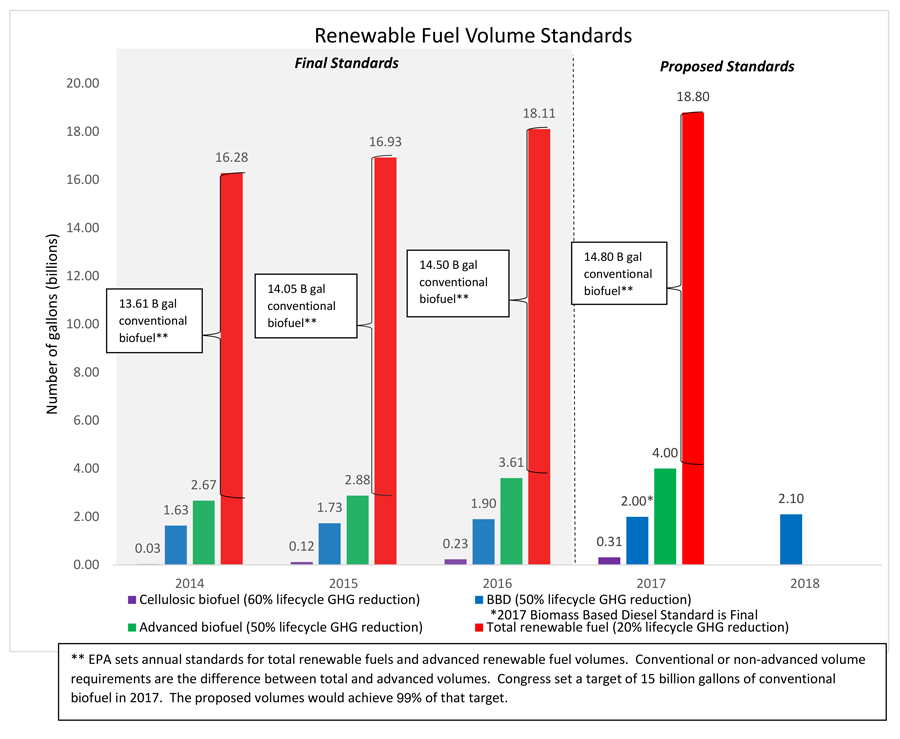Last May, the Environmental Protection Agency
proposed increases in renewable fuel volume requirements across all types of biofuels under the Renewable Fuel Standard (RFS) program. The proposed increases would boost renewable fuel production and provide for ambitious yet achievable growth.
Among the fuels, cellulosic ethanol--which requires 60 percent lifecycle carbon emissions reductions—would reach a historic level of production, growing by 82 million gallons, or 35 percent between 2016 and 2017.
CELLULOSIC FEEDSTOCK TECHNOLOGY
Cellulosic ethanol is primarily produced from agricultural residue, mostly from corn stover (leaves, stalks and husks) and wheat straw, which is sustainably removed after the harvest. However, many different cellulosic ethanol technologies and feedstocks exist, including organic landfill waste, algae, grasses and wood.
Second-generation bioproducts like cellulosic ethanol offer more benefits than first-generation bioproducts, especially in terms of land-use efficiency and proper environmental management. Second-generation biorefineries are produced from Feedstock 2, which includes a variety of raw materials that don't compete with food sources like lignocellulosic material, a product of agro-industrial activities such as the extraction of sugar or oil (e.g., cane bagasse, palm heart), rice husks and waste from the production of corn, among others.
ATTRACTING INVESTORS A KEY TO INDUSTRY GROWTH
EPA's proposed increase should help jump-start investor attraction in the cellulosic ethanol market. Brent Erickson, executive vice president of the Biotechnology Industry Organization (BIO),
believes the biggest challenge facing the cellulosic ethanol industry is reviving investment so that more biorefineries will continue to be built.
“BIO has estimated that EPA’s delays in issuing the RFS rules caused a $13.7 billion shortfall in the investment necessary to build cellulosic and advanced capacity,” he
tells Ethanol Production Magazine (EPM). “While the first-of-a-kind cellulosic plants were being completed, new plants should have been started or planned—there were some, but too few.”
Getting the RFS administered properly, fixing the bias in the tax code and continuing to expand the market for ethanol blends are critical, he says, for keeping the industry moving forward.
Erickson also tells EPM that another highlight of the past year is that EPA began considering whether cellulosic sugar producers, rather than only biomass-to-fuel producers, could participate in the RFS and generate RINs.
“There could be efficiencies in allowing one biorefinery to convert biomass to sugar, while another ferments the sugar to fuel,” he says. “EPA has indicated it will consider rules to enable this new pathway. And after years of unconscionable delays in approving pathways, this is another positive sign that EPA intends to make progress on approving new cellulosic biofuels.”
RULE SUMMARY
- Cellulosic biofuel—which requires 60 percent lifecycle carbon emissions reductions- would grow by 82 million gallons, or 35 percent between 2016 and 2017.
- Total renewable fuel volumes would grow by nearly 700 million gallons between 2016 and 2017.
- Advanced renewable fuel–which requires fifty percent lifecycle carbon emissions reductions–would grow by nearly 400 million gallons between 2016 and 2017.
- The non-advanced or “conventional” fuels portion of total renewable fuels–which requires a minimum of 20 percent lifecycle carbon emissions reductions—would increase by 300 million gallons between 2016 and 2017 and achieve 99 percent of the Congressional target of 15 billion gallons.
- Biomass-based biodiesel—which must achieve at least 50 percent lifecycle emissions reductions - would grow by 100 million gallons between 2017 and 2018.




